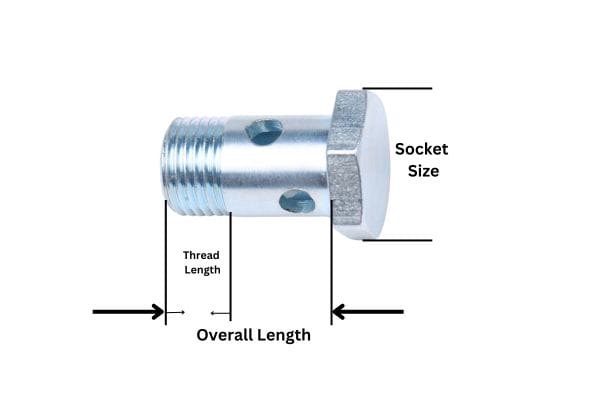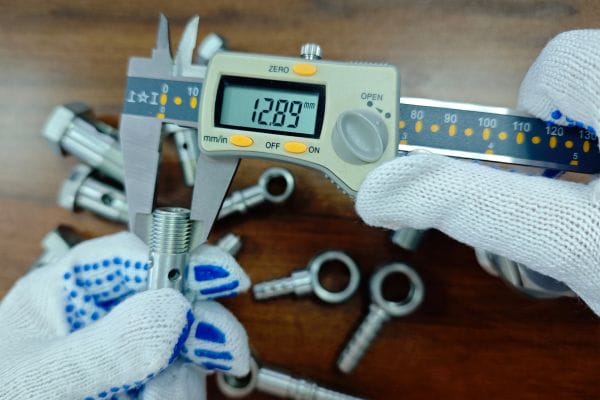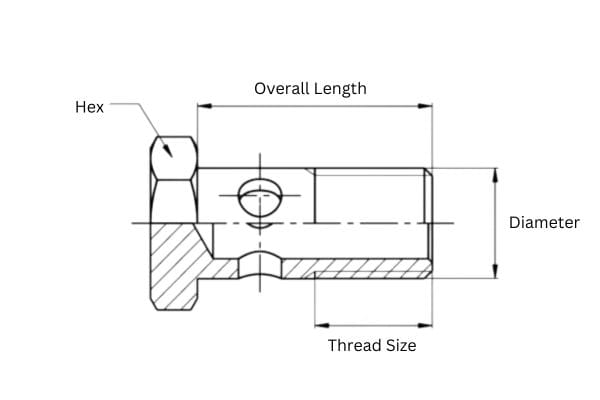Accurate bolt measurements are crucial in various industries, from automotive and aerospace to construction and manufacturing. These measurements ensure the integrity and safety of mechanical assemblies, preventing failures that can lead to costly downtime or even catastrophic accidents. This guide aims to provide a comprehensive understanding of metric bolt measurements, offering detailed insights into the components, dimensions, grades, and measurement techniques essential for selecting and using bolts correctly.
Metric bolts are a type of fastener that conform to the metric measurement system, which is the predominant standard used globally. Unlike imperial bolts, which are measured in inches, metric bolts are specified in millimeters, facilitating uniformity and compatibility in international projects. These bolts are available in a variety of sizes and grades, each tailored to meet specific application needs. The use of metric bolts ensures precision and standardization across diverse industries, making them essential components in engineering, manufacturing, and construction.
Accurate bolt measurements are essential for ensuring the integrity and safety of mechanical assemblies. Incorrect bolt dimensions can lead to improper fits, which may result in mechanical failures, structural weaknesses, or even catastrophic accidents. Precise measurements ensure that the bolts fit correctly, providing the necessary strength and stability. This is particularly crucial in industries where safety and reliability are paramount, such as aerospace, automotive, and construction.

Head
The head of a metric bolt is the top part that is usually shaped to accommodate a specific type of tool, such as a wrench or a screwdriver. Common head shapes include hexagonal, round, and flat. The head size and shape are important for the application as they determine the tool required for installation and the amount of torque that can be applied.
Shank
The shank is the unthreaded portion of the bolt that lies between the head and the thread. The length of the shank varies depending on the bolt’s intended use. It provides additional strength and helps in positioning the bolt correctly in the assembly.
Thread
The thread is the helical ridge that runs along the bolt’s length, starting from the shank to the end of the bolt. Threads are crucial for the bolt’s ability to screw into a nut or a threaded hole, providing the necessary clamping force to hold components together. The pitch of the thread, which is the distance between adjacent threads, is a critical measurement in ensuring compatibility with nuts and threaded holes.
Nut
The nut is a separate component that works with the bolt to fasten components together. It has an internal thread that matches the bolt’s external thread. The correct pairing of bolt and nut threads is vital for achieving the desired clamping force and ensuring the assembly’s stability.
Industries Using Metric Bolts
Metric bolts are widely used across various industries due to their standardization and reliability. Some of the key industries include:
Automotive: In the automotive industry, metric bolts are used extensively in the assembly of vehicles. They are essential for fastening parts such as engines, chassis, and body panels, ensuring the vehicle’s structural integrity and performance.
Construction: Construction projects often rely on metric bolts for assembling structural components, machinery, and equipment. These bolts are crucial for maintaining the safety and stability of buildings, bridges, and other infrastructures.
Machinery: In the manufacturing and machinery industries, metric bolts are used to assemble equipment, tools, and machines. They provide the necessary strength and precision required for the proper functioning of mechanical systems.
Understanding Bolt Dimensions
Diameter
Nominal Diameter
The nominal diameter of a bolt refers to the diameter of the bolt’s shank, which is the part without the threads. This measurement is crucial as it determines the bolt’s size category and ensures that it fits correctly in pre-drilled holes or nuts. The nominal diameter is typically specified in millimeters for metric bolts.
To measure the diameter of a bolt accurately, you can use a caliper. Place the caliper’s jaws around the unthreaded part of the bolt and read the measurement. Ensure that the caliper is perpendicular to the bolt to avoid skewed readings. For threaded sections, measuring across the threads at their widest point will give you the major diameter.
Overall Length vs. Grip Length
Overall Length: The overall length of a bolt is the total length from the flat part of the head to the tip of the bolt. This measurement is essential for determining how far the bolt will extend into the material or components it is fastening.
Grip Length: The grip length is the unthreaded portion of the bolt, which lies between the head and the start of the threads. This section bears the load and provides the clamping force required in the assembly. It is important to choose a bolt with an appropriate grip length to ensure a secure hold.
Tools for Measuring Bolt Length
To measure the length of a bolt, you can use a ruler or a caliper. For longer bolts, a ruler is sufficient. Place the bolt alongside the ruler, starting from the head to the tip, and note the measurement. For more precision, especially with shorter bolts, a caliper is preferred. Ensure that the bolt is straight when taking the measurement to avoid inaccuracies.

Thread pitch is the distance between adjacent threads on a bolt, measured parallel to the bolt’s axis. It is usually specified in millimeters for metric bolts. For example, a bolt with a thread pitch of 1.5 mm has 1.5 millimeters between each thread. The thread pitch is critical for ensuring compatibility between the bolt and the nut or threaded hole, as it affects the fit and the fastening strength.
Methods for Measuring Thread Pitch
To measure thread pitch, you can use a thread gauge or a caliper. A thread gauge consists of multiple blades, each marked with a different pitch. Simply match the bolt’s threads to the gauge’s blades until you find the one that fits perfectly. Alternatively, using a caliper, measure the distance between the peaks of two adjacent threads and note the measurement.
Different Types of Bolt Heads
Bolts come with various head types, each designed for specific applications and tools. Common types include:
Hexagonal Head: Widely used for its ease of installation with a wrench or socket.
Round Head: Often used where a low-profile head is needed.
Flat Head: Designed to sit flush with the material surface, providing a smooth finish.
Socket Head: Used in applications requiring a recessed head, installed with an Allen wrench.
Measuring Head Dimensions
To measure the head dimensions, you need to consider both the diameter and the height of the head. Use a caliper to measure the diameter across the flats for hexagonal heads or the overall diameter for round heads. Measure the height from the base to the top of the head. These measurements are important for ensuring that the bolt head fits within the intended space and can be properly engaged by the appropriate tool.
Understanding these dimensions is crucial for selecting the right bolt for your application, ensuring proper fit, and achieving the desired mechanical performance. Accurate measurement techniques and tools are essential for maintaining the integrity and safety of your assemblies.
Metric bolts come in various grades, each indicating the bolt’s strength and suitability for different applications. The grade of a bolt is determined by its material composition and the heat treatment it has undergone. Higher grade bolts are made from stronger materials and are subjected to more rigorous heat treatments, making them suitable for applications that require higher strength and durability. Common metric bolt grades include:
Grade 4.6: Typically used for light-duty applications. It has a tensile strength of 400 MPa and a yield strength of 240 MPa.
Grade 8.8: One of the most common grades, suitable for medium-duty applications. It has a tensile strength of 800 MPa and a yield strength of 640 MPa.
Grade 10.9: Used for high-strength applications, this grade offers a tensile strength of 1000 MPa and a yield strength of 900 MPa.
Grade 12.9: The highest common grade, used in the most demanding applications. It has a tensile strength of 1200 MPa and a yield strength of 1080 MPa.
Some metric bolts are marked with their grade on the head, which makes it easy to identify their strength and material composition. These markings usually consist of two numbers separated by a dot. The first number represents one-tenth of the nominal tensile strength in MPa, while the second number is the ratio of yield strength to tensile strength. For example, a Grade 8.8 bolt has a tensile strength of 800 MPa and a yield strength of 80% of that, or 640 MPa. Additionally, bolts may have other markings to indicate the manufacturer’s identification or other specific attributes.
Tensile Strength
Tensile strength is the maximum amount of tensile (pulling) stress that a bolt can withstand before failing. It is a critical parameter for determining the suitability of a bolt for a particular application. High tensile strength is required in applications where the bolt will be subjected to significant stretching forces.
Yield Strength
Yield strength is the amount of stress at which a bolt begins to deform plastically. Below this stress, the bolt will return to its original shape when the load is removed. Above this stress, the bolt will be permanently deformed. Yield strength is an important consideration in applications where the bolt will be subjected to constant or fluctuating loads, as it indicates the load level beyond which the bolt will not maintain its shape.
Proof Load
Proof load is the maximum stress that a bolt can withstand without any permanent deformation. It is a safety margin below the yield strength, ensuring that the bolt remains functional under the specified load. Proof load testing is typically performed to verify the bolt’s quality and performance in real-world conditions.
Selecting the right bolt grade is crucial for ensuring the safety, reliability, and performance of the assembly. Here are some factors to consider:
Load Requirements: Determine the tensile and shear loads the bolt will be subjected to. Higher loads require bolts with higher tensile and yield strength.
Environmental Conditions: Consider the operating environment, such as exposure to moisture, chemicals, or extreme temperatures. Stainless steel or coated bolts may be necessary for corrosive environments.
Material Compatibility: Ensure the bolt material is compatible with the materials being fastened. This helps prevent galvanic corrosion and other material-related issues.
Safety Margins: Always choose a bolt grade that provides a sufficient safety margin beyond the maximum expected load to account for unexpected stresses and ensure long-term reliability.
Cost and Availability: While higher-grade bolts offer superior strength, they are also more expensive. Balance the cost with the application’s requirements to make an economical choice without compromising safety.
The first step in customizing a metric bolt fitting is to create a detailed blueprint. This involves drafting a technical drawing that outlines all the specifications of the bolt, including its dimensions, thread type, head shape, and any special features. Ensure that the blueprint adheres to industry standards and includes precise measurements and tolerances. Collaboration with engineers or designers might be necessary to ensure the blueprint meets the required functionality and compatibility with other components.

Once the blueprint is ready, the next step is to select the appropriate dimensions for your custom bolt. This includes:
Diameter: Choose the nominal diameter based on the load requirements and the size of the holes it will pass through.
Length: Determine the overall length, ensuring it provides the necessary clamping force and fits the intended application.
Thread Pitch: Select the correct thread pitch to ensure compatibility with the corresponding nuts or threaded holes.
Accurate dimension selection is critical for ensuring the bolt performs as expected in its application.
The material of the bolt is crucial for its strength, durability, and suitability for the intended environment. Consider the following factors when choosing the material:
Load Requirements: High-strength applications may require alloy steel or other high-strength materials.
Corrosion Resistance: For environments exposed to moisture or chemicals, consider materials like stainless steel or bolts with corrosion-resistant coatings.
Temperature Resistance: If the bolt will be used in high-temperature environments, select materials that can withstand the thermal stresses.
Common materials for metric bolts include carbon steel, alloy steel, stainless steel, and titanium. Each material has its own set of properties, so it’s important to choose one that matches the specific needs of your application.
In this comprehensive guide on metric bolt measurements, we covered essential aspects of understanding and selecting the right metric bolts for various applications. We defined metric bolts and emphasized the importance of accurate measurements. We explored bolt dimensions—diameter, length, thread pitch, and head size—along with measurement techniques. Additionally, we discussed bolt grades, strength specifications, and factors to consider when choosing the right grade. Finally, we outlined steps for customizing metric bolt fittings. To ensure accuracy, use proper tools, regularly calibrate instruments, double-check measurements, understand specifications, and consult experts. Apply this knowledge to enhance project reliability, and share the guide to promote best practices across industries.
Metric bolts are fasteners measured in millimeters, adhering to the metric system, which is the standard used worldwide.
Use a caliper to measure the diameter of the bolt’s shank (unthreaded part) or the major diameter (widest part) of the threaded section.
Thread pitch is the distance between adjacent threads, measured parallel to the bolt’s axis. It ensures compatibility with nuts or threaded holes.
Bolt grades indicate the strength and material composition of the bolt, helping to determine its suitability for different applications.
Use high-quality measuring tools, regularly calibrate them, double-check measurements, and familiarize yourself with industry standards.
Consider load requirements, environmental conditions, material compatibility, safety margins, and cost to select the appropriate bolt grade for your application.